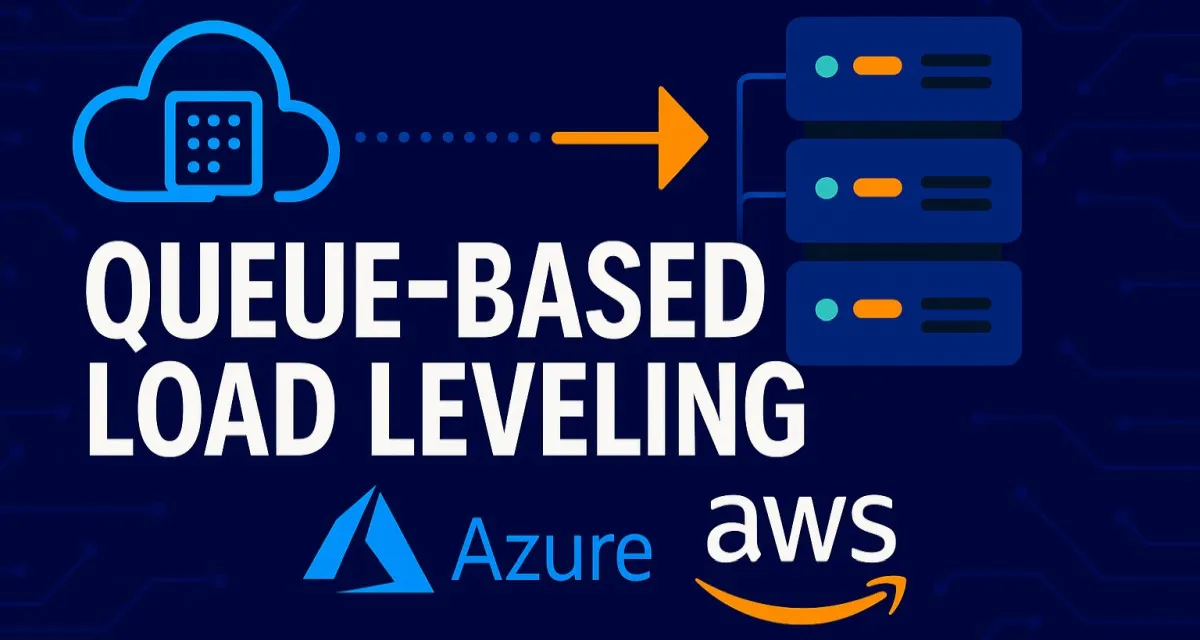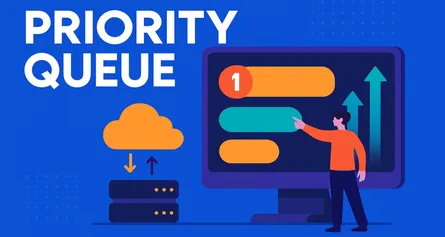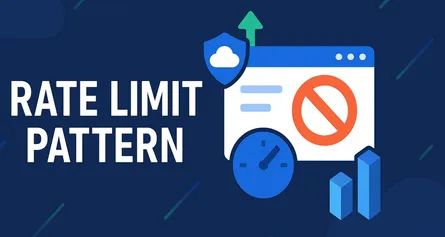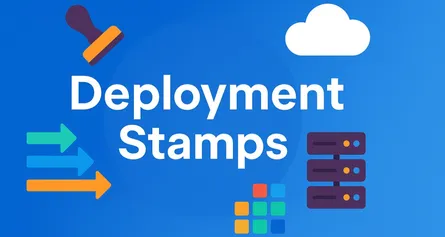
Mastering the Queue-Based Load Leveling Pattern: Ensuring Cloud Stability with C#
Modern cloud applications are a marvel of technological achievement. They scale elastically, handle immense workloads, and keep complex systems running smoothly—or at least, that’s the ideal scenario. In reality, cloud workloads are unpredictable, and without careful planning, they can topple even the most robust applications. As software architects, how can we maintain system stability when facing sudden bursts of traffic? How do we avoid overwhelming critical services?
The answer lies in understanding and implementing the Queue-Based Load Leveling pattern.
1. Introduction: The Unpredictable Cloud and the Need for Stability
Cloud computing has introduced unprecedented flexibility and scalability. But this elasticity often comes at the price of unpredictability. Applications experience periods of intense activity followed by quiet lulls, a challenge that complicates resource management and architectural design.
1.1. The Architect’s Challenge: Bursty, Unpredictable Workloads
Imagine your e-commerce site during Black Friday: traffic suddenly surges, orders flood in, and your order-processing system is pushed to its limits. Or consider a news website breaking a major story, experiencing unexpected spikes as readers rush in simultaneously.
These bursty workloads test even the best-designed systems. Traditional architectures that rely on direct, synchronous interactions between components often falter under such unpredictable demand.
1.2. The Perils of Direct Synchronous Calls
When systems are tightly coupled through synchronous calls, every component becomes dependent on the immediate responsiveness of others. For example, suppose your application directly calls a payment gateway each time a customer places an order. If the gateway slows down or becomes overwhelmed, your entire ordering process grinds to a halt. Customers experience delays, and frustration mounts.
Direct synchronous calls create choke points. They lead to cascading failures, reduced availability, and poor user experience.
1.3. A Shift in Thinking: Embracing Asynchronicity
To solve this, software architects must embrace asynchronous communication. Decoupling components through asynchronous mechanisms introduces resilience into the architecture. Components no longer wait idly for others to respond—they simply pass along their tasks, freeing them to continue their work independently.
This approach is akin to dropping letters into a mailbox. You don’t need to wait around for the mail carrier—you simply drop the letter and trust it will be delivered later.
1.4. Introducing the Queue-Based Load Leveling Pattern
The Queue-Based Load Leveling pattern is designed specifically to address bursty workloads. It introduces a queue as an intermediary buffer between components. The queue absorbs rapid fluctuations, smoothing out traffic spikes by allowing services to process tasks at a sustainable, predictable pace.
By placing this queue between task-producing clients and task-consuming services, architects create a robust, fault-tolerant system capable of gracefully handling unpredictable loads.
2. Deep Dive into the Queue-Based Load Leveling Pattern
To thoroughly understand the Queue-Based Load Leveling pattern, let’s examine its components, workflow, and the tangible benefits it provides.
2.1. Core Components and Terminology
The pattern revolves around four key components:
2.1.1. The Task/Message
The task or message represents the unit of work. It could be an order, an image to process, a transaction, or any job requiring processing.
2.1.2. The Client/Producer
This is the component generating tasks. Typically, it’s a frontend application, API endpoint, or another backend service.
2.1.3. The Queue
The queue is a reliable storage mechanism. It buffers incoming tasks, allowing the system to handle sudden traffic bursts smoothly.
2.1.4. The Service/Consumer
This component retrieves tasks from the queue at a steady pace, processing them independently of incoming task frequency.
2.2. How It Works: A Step-by-Step Flow
Let’s walk through the Queue-Based Load Leveling pattern step by step, illustrating each stage clearly.
2.2.1. Task Submission
When the client generates tasks, it submits them rapidly to the queue without waiting for immediate acknowledgment or processing completion.
Here’s a simple example using Azure Queue Storage in C#:
// Task Submission Example with Azure Queue
using Azure.Storage.Queues;
using System.Threading.Tasks;
public class TaskProducer
{
private readonly QueueClient _queueClient;
public TaskProducer(string connectionString, string queueName)
{
_queueClient = new QueueClient(connectionString, queueName);
_queueClient.CreateIfNotExists();
}
public async Task SubmitTaskAsync(string taskMessage)
{
await _queueClient.SendMessageAsync(taskMessage);
}
}2.2.2. Buffering
The queue safely holds these tasks. Even if thousands of requests arrive simultaneously, the queue manages them gracefully, temporarily storing them until the service is ready to process them.
2.2.3. Task Consumption
Services consume tasks at their own controlled pace, pulling messages from the queue one at a time or in manageable batches. This ensures the processing components are not overwhelmed, even under heavy loads.
Here’s a consumer example using Azure Queue Storage:
// Task Consumption Example with Azure Queue
using Azure.Storage.Queues;
using System.Threading.Tasks;
public class TaskConsumer
{
private readonly QueueClient _queueClient;
public TaskConsumer(string connectionString, string queueName)
{
_queueClient = new QueueClient(connectionString, queueName);
_queueClient.CreateIfNotExists();
}
public async Task ProcessTasksAsync()
{
while (true)
{
var message = await _queueClient.ReceiveMessageAsync();
if (message.Value != null)
{
// Process the task
HandleTask(message.Value.MessageText);
// Delete the message once processed
await _queueClient.DeleteMessageAsync(message.Value.MessageId, message.Value.PopReceipt);
}
else
{
// No tasks in queue; pause briefly
await Task.Delay(1000);
}
}
}
private void HandleTask(string taskMessage)
{
// Implement your task handling logic here
}
}2.3. Key Benefits for Cloud Architects
Implementing the Queue-Based Load Leveling pattern provides substantial advantages for architects designing cloud-based applications.
2.3.1. Enhanced Availability and Resilience
By decoupling the consumer from direct synchronous calls, services remain responsive under heavy load. Even if the service temporarily slows down or experiences issues, new tasks simply queue up, waiting patiently for processing.
2.3.2. Improved Scalability
Clients and services scale independently, based on their distinct performance and resource demands. If the client generates more tasks, you simply scale the queue or add more consumers—no drastic reconfiguration needed.
2.3.3. Cost Optimization
Because queues handle peak load buffering, architects provision resources based on average load rather than peak load. This avoids expensive over-provisioning while maintaining responsiveness during spikes.
2.3.4. Increased Reliability
Tasks are securely stored in the queue, minimizing the risk of losing work during temporary outages. Services pick up right where they left off once restored, ensuring no data or jobs are lost.
3. Common Use Cases for .NET Applications
The Queue-Based Load Leveling pattern isn’t just an abstract architectural principle—it’s an essential tool in the .NET developer’s toolbox. Let’s explore how this pattern is applied to real-world scenarios, highlighting its flexibility and impact in typical .NET cloud solutions.
3.1. E-commerce Order Processing: Handling a Massive Influx of Orders
Picture an online shop built on ASP.NET Core. It’s running a flash sale, and thousands of users flood the website within minutes. The web layer (the client/producer) needs to accept these orders instantly, but the back-end order processor (the consumer) has limited resources and must interact with payment gateways, inventory systems, and shipping providers.
Direct synchronous processing would create a bottleneck—users might wait for seconds or even minutes, or the system could become unresponsive. Instead, the order API quickly places each new order message onto a queue (such as Azure Queue Storage or Azure Service Bus). The order-processing service then picks up orders one at a time, updating the inventory, processing payments, and confirming shipments as capacity allows.
Example: Order Submission in C#
public async Task<IActionResult> SubmitOrder([FromBody] OrderRequest orderRequest)
{
var message = JsonSerializer.Serialize(orderRequest);
await _queueClient.SendMessageAsync(message);
return Accepted(); // Respond immediately
}This approach ensures every customer’s order is acknowledged right away, even during peak demand, and back-end services process orders as quickly as they can—no overload, no lost orders.
3.2. Image and Video Processing: Offloading Resource-Intensive Transcoding Tasks
Media-rich platforms often require resizing images, generating thumbnails, or transcoding videos for various devices. These tasks are CPU- and memory-intensive, and running them synchronously would make the web application sluggish or unstable.
With a queue-based pattern, the web application immediately enqueues the image or video processing request, then returns control to the user. Specialized worker services consume messages from the queue and process them in isolation, leveraging powerful compute instances or even serverless options like Azure Functions.
Example: Queueing a Video Processing Task
public async Task<IActionResult> UploadVideo([FromForm] IFormFile videoFile)
{
var videoTask = new VideoTask { FileName = videoFile.FileName, UploadedAt = DateTime.UtcNow };
var message = JsonSerializer.Serialize(videoTask);
await _queueClient.SendMessageAsync(message);
// The file is stored; processing happens in the background
return Accepted();
}This ensures that even if hundreds of uploads happen simultaneously, users get quick feedback, and the heavy lifting is handled asynchronously, scaling out worker services as needed.
3.3. IoT Data Ingestion: Managing High-Velocity Data Streams
IoT solutions built with .NET often ingest telemetry from thousands or millions of sensors and devices. These devices generate data at unpredictable intervals, sometimes flooding the system during events or peak hours.
Using a queue, device gateways or microservices acting as producers enqueue telemetry data for processing. Downstream analytics, alerting, or storage services (the consumers) read from the queue at a sustainable rate, ensuring no data is lost if downstream systems slow down.
Example: Enqueueing IoT Telemetry Data
public async Task IngestTelemetryAsync(TelemetryEvent telemetry)
{
var json = JsonSerializer.Serialize(telemetry);
await _queueClient.SendMessageAsync(json);
}This buffering strategy provides elasticity. If an analytics service needs scaling, more consumers can be added without modifying the data ingestion logic.
3.4. Batch Job Processing: Executing Large-Scale Data Jobs
Batch processing is another domain where queue-based load leveling shines. Imagine an application that runs nightly data aggregation or report generation jobs. Submitting all jobs synchronously would require huge compute power for short periods, leading to wasted resources.
Instead, each batch job is enqueued as a message. A pool of worker services (perhaps running in containers or Azure Batch) consumes and processes these jobs as resources become available, often pulling tasks in parallel to maximize throughput.
Example: Scheduling a Batch Processing Job
public async Task ScheduleBatchJobAsync(BatchJob job)
{
var message = JsonSerializer.Serialize(job);
await _queueClient.SendMessageAsync(message);
}Batch workers can be scaled up or down based on queue length, ensuring efficient resource utilization and no missed deadlines.
3.5. API Throttling and Rate Limiting: Protecting Downstream Services
Many modern APIs need to integrate with third-party services that impose strict rate limits. Exceeding these limits may lead to throttling or service suspension.
In a queue-based architecture, API requests from clients are placed into a queue. A controlled set of consumers process these requests, ensuring the rate never exceeds downstream limits. If there’s a sudden spike, the queue absorbs the excess; consumers process requests at a consistent, safe rate.
Example: Implementing Rate-Limited API Calls
public async Task ProcessApiRequestsAsync()
{
var rateLimit = 100; // e.g., 100 requests/min
var interval = TimeSpan.FromMinutes(1) / rateLimit;
while (true)
{
var message = await _queueClient.ReceiveMessageAsync();
if (message.Value != null)
{
// Call downstream API
await CallThirdPartyApiAsync(message.Value.MessageText);
await _queueClient.DeleteMessageAsync(message.Value.MessageId, message.Value.PopReceipt);
await Task.Delay(interval); // Enforce rate limit
}
else
{
await Task.Delay(1000); // No tasks in queue; pause
}
}
}This technique safeguards downstream dependencies and offers a straightforward path to handling variable client demand without risking API lockout.
4. Implementation in the Microsoft Azure Ecosystem with C#
Microsoft Azure offers mature, flexible queueing services, making it a prime platform for applying the Queue-Based Load Leveling pattern with .NET. Deciding between available options, structuring your components, and managing scaling all contribute to the solution’s overall effectiveness.
4.1. Choosing the Right Azure Queueing Service
Selecting the appropriate queueing technology is fundamental. Azure provides two primary options: Azure Storage Queues and Azure Service Bus Queues. Both deliver reliable, scalable message handling but suit different architectural needs.
4.1.1. Azure Storage Queues
Azure Storage Queues are designed for simple, massive-scale workloads. They’re cost-effective and straightforward, ideal when you need a basic queue without advanced messaging features.
- When to use: High-volume, throughput-focused scenarios, such as telemetry buffering or background processing.
- Limitations: Lacks support for advanced scenarios like message ordering, sessions, or transactions.
4.1.2. Azure Service Bus Queues
Azure Service Bus Queues are enterprise-grade. They provide robust capabilities—sessions, transactions, dead-lettering, duplicate detection, and message deferral—suiting complex, mission-critical systems.
- When to use: Workflows requiring guaranteed order, at-most-once delivery, or integration with other enterprise messaging features.
- Example scenarios: Financial processing, critical business workflows.
4.2. Architecting the Solution with Azure Functions and Service Bus
A common cloud-native architecture pairs a .NET API as the producer and Azure Functions as the consumer. Azure Functions scale seamlessly, making them an excellent fit for the load-leveling pattern.
4.2.1. The Producer: .NET Web API Enqueueing Messages
The producer accepts requests (such as order submissions) and adds them to the Service Bus queue. The latest Azure SDK simplifies this integration.
4.2.2. The Consumer: Azure Function with a Service Bus Trigger
Azure Functions, triggered by Service Bus messages, serve as lightweight consumers. They process incoming tasks independently and scale out as message volume grows.
4.2.3. C# Code Walkthrough
4.2.3.1. Producer Logic: Sending Messages with Azure.Messaging.ServiceBus
using Azure.Messaging.ServiceBus;
public class QueueProducer
{
private readonly ServiceBusSender _sender;
public QueueProducer(string connectionString, string queueName)
{
var client = new ServiceBusClient(connectionString);
_sender = client.CreateSender(queueName);
}
public async Task SendMessageAsync<T>(T payload)
{
var json = JsonSerializer.Serialize(payload);
var message = new ServiceBusMessage(json);
await _sender.SendMessageAsync(message);
}
}4.2.3.2. Consumer Logic: Azure Function with Error Handling
public class QueueConsumer
{
[Function("ProcessQueueMessage")]
public async Task Run(
[ServiceBusTrigger("orders-queue", Connection = "ServiceBusConnection")]
string message,
FunctionContext context)
{
try
{
var order = JsonSerializer.Deserialize<Order>(message);
// Process the order
}
catch (Exception ex)
{
var logger = context.GetLogger("QueueConsumer");
logger.LogError(ex, "Error processing message");
throw; // Optionally, let Azure Functions move the message to dead-letter
}
}
}Azure Functions automatically handles retries, dead-lettering, and logging. This minimizes the operational burden on your team.
4.3. Scaling the Consumer
Modern workloads fluctuate. Azure Functions’ elasticity is a key advantage in load leveling.
4.3.1. Leveraging the Azure Functions Consumption Plan
The Consumption Plan enables your functions to scale out automatically based on queue length. As more messages arrive, Azure provisions additional function instances, processing tasks in parallel without manual intervention.
4.3.2. Configuring host.json for Concurrency
You can fine-tune concurrency and batch settings in your host.json configuration:
{
"extensions": {
"serviceBus": {
"prefetchCount": 20,
"messageHandlerOptions": {
"maxConcurrentCalls": 16,
"autoComplete": true
}
}
}
}maxConcurrentCalls: Sets the maximum parallel function executions.prefetchCount: Controls how many messages to prefetch for efficiency.
This ensures you never overwhelm downstream systems while maintaining responsiveness during spikes.
4.4. Architectural Diagram: Azure Implementation
Below is a conceptual overview of the Azure pattern implementation:
[Client Apps]
|
v
[.NET API (Producer)]
|
v
[Azure Service Bus Queue]
|
v
[Azure Functions (Consumer)]
|
v
[Downstream Processing/Database/External Services]This decoupled architecture maximizes resilience, scalability, and operational simplicity, all within Azure’s managed ecosystem.
5. Implementation in AWS with C# and .NET
Amazon Web Services (AWS) offers its own robust queueing technologies, most notably Amazon Simple Queue Service (SQS). .NET developers can seamlessly integrate these tools, leveraging similar producer-consumer architectures to achieve cloud-native reliability and scalability.
5.1. Introduction to Amazon Simple Queue Service (SQS)
Amazon SQS is a fully managed message queueing service, designed for high-throughput and reliability. It offers two main queue types:
5.1.1. Standard Queues
- Best for: Most scenarios requiring high-throughput and at-least-once message delivery.
- Characteristics: Nearly unlimited transactions per second, eventual consistency in delivery order.
5.1.2. FIFO Queues
- Best for: Workloads requiring strict message order and exactly-once processing.
- Characteristics: Guaranteed message order and deduplication, slightly lower throughput than Standard Queues.
5.2. Building the Pattern with .NET on AWS
Let’s walk through a typical SQS integration in the AWS ecosystem.
5.2.1. The Producer: .NET Application Sending to SQS
A .NET app—perhaps an ASP.NET Core API running on EC2, ECS, or Fargate—produces messages and enqueues them using AWS SDKs.
5.2.2. The Consumer: AWS Lambda or ECS Worker Service
The consumer can be an AWS Lambda function written in C# or a .NET Worker Service running on ECS. Both approaches allow flexible scaling and efficient background processing.
5.2.3. C# Code Walkthrough
5.2.3.1. Producer Logic: Using AWSSDK.SQS
First, install the AWSSDK.SQS NuGet package.
using Amazon.SQS;
using Amazon.SQS.Model;
public class SqsProducer
{
private readonly IAmazonSQS _sqsClient;
private readonly string _queueUrl;
public SqsProducer(IAmazonSQS sqsClient, string queueUrl)
{
_sqsClient = sqsClient;
_queueUrl = queueUrl;
}
public async Task SendMessageAsync<T>(T payload)
{
var messageBody = JsonSerializer.Serialize(payload);
var request = new SendMessageRequest
{
QueueUrl = _queueUrl,
MessageBody = messageBody
};
await _sqsClient.SendMessageAsync(request);
}
}5.2.3.2. Consumer Logic: Lambda Function Handler
Here’s an example Lambda handler written in C#:
public class SqsConsumer
{
public async Task FunctionHandler(SQSEvent evnt, ILambdaContext context)
{
foreach (var record in evnt.Records)
{
try
{
var message = record.Body;
// Deserialize and process message
}
catch (Exception ex)
{
context.Logger.LogLine($"Error processing message: {ex.Message}");
// Optionally: move to DLQ or alert
}
}
}
}Alternatively, a long-running .NET Worker Service on ECS or EC2 can poll SQS and process messages continuously, providing even more flexibility for custom scaling logic.
5.3. Autoscaling in AWS
Elasticity is fundamental to the load leveling pattern. AWS supports autoscaling for both Lambda and ECS-based consumers.
5.3.1. Lambda’s Automatic Scaling
AWS Lambda automatically polls SQS and spins up multiple concurrent executions as queue length grows. This ensures timely processing of backlogged messages without any manual scaling.
5.3.2. Scaling ECS Services
When using ECS for consumers, CloudWatch Alarms can monitor SQS queue depth and trigger scaling policies. As messages accumulate, ECS adds more consumer tasks. When the queue shrinks, tasks are deprovisioned.
This autoscaling aligns compute resources with actual workload, optimizing cost and performance.
5.4. Architectural Diagram: AWS Implementation
A conceptual overview of the AWS queue-based load leveling architecture:
[Client Apps]
|
v
[.NET API (Producer) on EC2/ECS/Fargate]
|
v
[Amazon SQS Queue]
|
v
[AWS Lambda Functions or ECS Worker Services (Consumer)]
|
v
[Downstream Processing/Database/External Services]This design ensures decoupling, resilience, and on-demand scalability—key benefits for mission-critical .NET applications on AWS.
6. Advanced Architectural Considerations and Best Practices
Designing a queue-based solution that truly stands up under real-world pressure requires more than wiring together a producer and consumer. To make your system robust and maintainable, it’s vital to account for advanced concerns like idempotency, poison message handling, observability, and sound message contracts.
6.1. Idempotent Consumers: A Must-Have
6.1.1. Understanding “At-Least-Once” Delivery
Most managed queueing systems—including Azure Service Bus and AWS SQS—guarantee at-least-once message delivery. This ensures no message is lost, even if there are transient failures or timeouts. However, it also means a message may be delivered more than once. Imagine a consumer processes a message, but network latency prevents an acknowledgment from reaching the queueing service. The queue then redelivers the message, and without precautions, your consumer might process it twice.
6.1.2. Techniques for Idempotency in C#
To guard against duplicates, consumers must be idempotent—processing the same message more than once should yield the same outcome as processing it once. Several techniques can help:
-
Tracking Processed Message IDs: Store each processed message’s unique ID in a fast-access data store (e.g., Redis, SQL with a unique index). Ignore messages with IDs that have already been processed.
public async Task HandleMessageAsync(Message message) { if (await _dbContext.ProcessedMessages.AnyAsync(m => m.Id == message.Id)) return; // Already processed // Proceed with processing await ProcessBusinessLogic(message); // Mark as processed _dbContext.ProcessedMessages.Add(new ProcessedMessage { Id = message.Id }); await _dbContext.SaveChangesAsync(); } -
Optimistic Concurrency: Use database-level constraints (e.g., unique keys, row versions) to prevent double-inserts or double-updates.
-
Designing Atomic Operations: Where possible, structure business logic so that repeating an operation doesn’t cause side effects—such as making the same API call or charging a customer twice.
6.2. Handling Poison Messages and the Dead-Letter Queue (DLQ)
6.2.1. The Problem: Poison Messages
Not all failures are transient. Some messages may be malformed or reference missing data, causing the consumer to fail consistently. These are called poison messages.
6.2.2. The Solution: Dead-Letter Queue
Most queueing services provide a dead-letter queue (DLQ). After a configurable number of failed delivery attempts, a poison message is automatically moved to the DLQ. This prevents it from blocking the queue or causing repeated failures.
6.2.3. Architecting a DLQ Strategy
- Responsibility: Assign a clear owner—often an operations or support team—to monitor and investigate the DLQ.
- Monitoring: Set up alerts when messages land in the DLQ.
- Reprocessing: Analyze, fix, and, if possible, replay messages after resolving underlying issues. Implement tooling or manual procedures for safe DLQ handling.
6.3. Monitoring and Observability
Operational excellence relies on transparency. Without the right telemetry, issues can go undetected until they affect users.
6.3.1. Key Metrics to Monitor
- Queue Length: Is the queue growing unexpectedly? This may signal a bottleneck.
- Message Age: Are messages sitting in the queue too long before being processed?
- Processing Time: How long does it take consumers to process each message?
- DLQ Count: Are messages accumulating in the dead-letter queue?
6.3.2. Tools for the Job
- Azure Monitor & Application Insights: Offer out-of-the-box metrics and logging for Azure resources, including queue and function monitoring.
- AWS CloudWatch: Tracks SQS queue depth, message age, Lambda errors, and more.
- Custom Dashboards: Bring together these metrics for a unified view of system health. Set up alerts for abnormal patterns.
6.4. Message Design and Contracts
The way you structure and evolve your messages has far-reaching effects on system compatibility and maintainability.
6.4.1. Versioning your Message Schemas
Change is inevitable. If you must alter your message format, do so without breaking existing consumers:
- Additive Changes: Prefer adding new fields with default values rather than removing or renaming existing ones.
- Explicit Versioning: Include a
versionproperty in your message and handle multiple versions in your consumer code if necessary. - Schema Validation: Use tools (e.g., JSON Schema) to validate message structure on receipt.
6.4.2. Small vs. Large Messages: The “Claim-Check” Pattern
Queues have message size limits (e.g., 256KB for Azure Storage Queues, 256KB for SQS). Large payloads—such as images or large documents—should not be sent directly.
- Claim-Check Pattern: Upload large content to a durable storage service (Azure Blob Storage or Amazon S3), then send a reference (e.g., URL or blob ID) in the message.
- Benefits: Keeps queue traffic fast and cheap, avoids size limits, and allows retrying downloads independently of message delivery.
7. Combining Patterns for Enhanced Solutions
Queue-based load leveling is often even more powerful when used with other well-known patterns.
7.1. Queue-Based Load Leveling + Competing Consumers
Deploying multiple consumer instances—known as the Competing Consumers pattern—enables parallel message processing and throughput scaling. Each consumer pulls from the same queue, improving overall processing rates and reducing queue backlog. This model is supported natively by both Azure Functions and AWS Lambda.
7.2. Queue-Based Load Leveling + Throttling
In some scenarios, downstream services (such as payment gateways or third-party APIs) cannot accept unlimited requests. Pairing queue-based load leveling with a Throttling pattern ensures the consumer processes messages at a controlled rate, smoothing bursts and respecting rate limits.
- Implemented by controlling the concurrency or by introducing deliberate processing delays in your consumers.
7.3. Queue-Based Load Leveling + Circuit Breaker
Sometimes, a dependency fails or becomes unreliable. If your consumer continues pulling and processing messages, it can amplify failures or lead to message loss. Integrating a Circuit Breaker pattern lets your consumer temporarily pause message processing when downstream services are failing, preventing a bad situation from escalating and allowing for graceful recovery.
- If the circuit is “open,” the consumer can re-queue or delay processing of current messages, or even move them to a quarantine queue for later reprocessing.
8. Conclusion: The Architect’s Role in Building Resilient Systems
8.1. Summary of the Pattern’s Value
The Queue-Based Load Leveling pattern addresses a critical need in cloud-native architectures: smoothing unpredictable workloads, decoupling components, and shielding downstream services from spikes. Its benefits—improved availability, flexible scalability, and lower costs—are foundational for any robust distributed application.
8.2. Key Takeaways for .NET Architects
- Decouple producers and consumers to increase system resilience and flexibility.
- Design consumers for idempotency to handle at-least-once delivery safely.
- Monitor and manage poison messages using dead-letter queues.
- Keep a close eye on metrics such as queue depth, message age, and processing duration.
- Version message contracts and use the claim-check pattern for large payloads.
- Combine patterns like competing consumers, throttling, and circuit breakers to address additional architectural concerns.
8.3. Final Thoughts
As cloud systems grow more complex, the architectural choices you make today determine your application’s stability and maintainability tomorrow. The Queue-Based Load Leveling pattern is not merely a best practice—it’s a core strategy for any .NET solution that aspires to handle real-world scale and complexity. When thoughtfully applied, it forms the backbone of reliable, efficient, and scalable cloud-native systems.
For the modern .NET architect, mastering this pattern—and the patterns that complement it—isn’t optional. It’s essential.
Share this article
Help others discover this content
About Sudhir mangla
Content creator and writer passionate about sharing knowledge and insights.
View all articles by Sudhir mangla →




